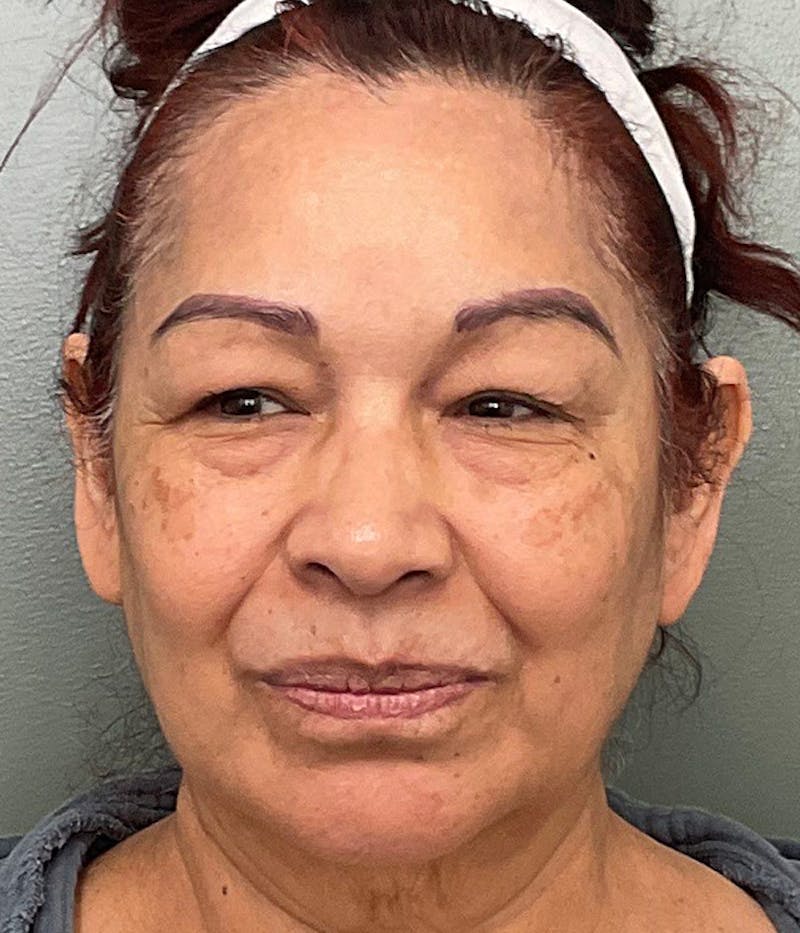Dr. Michael Baumholtz is a dual board certified Plastic and Reconstructive Surgeon in San Antonio. His style is straightforward. He explains what the surgery can and cannot do, keeps the plan simple, and stays close during recovery. No hype. No guarantees. Just a clear path from consult to follow up.
Blepharoplasty can address heavy upper lids, lower lid bags, or both. The aim is cleaner contours around the eyes while protecting how the lids move and how the eyes feel. Upper lids usually need a careful trim of extra skin and a thin strip of muscle. Fat is adjusted only if it is part of the problem. For lower lids, he often works from the inside of the lid to adjust the fat pads. If there is a little loose skin, he may add a small pinch of skin on the outside. Most people go home the same day. Early check ins are routine.
Goals Of Surgery
The goal is a fresh, rested look that fits the face. Dr. Baumholtz favors conservative changes. He protects blink function and tear film first, then shapes what needs shaping. He avoids over removal of fat and skin because that can cause hollowing or tight lids that do not feel right.
Who May Be A Candidate
People come in when upper lid skin sits on the lashes or when lower lids look puffy even after good sleep. Good candidates have healthy eyes and realistic timelines for healing. Some conditions need attention before surgery. Dry eye, active eyelid inflammation, thyroid eye disease, uncontrolled blood pressure or diabetes, and nicotine use can change the plan or timing. If you take blood thinners, he will coordinate with your prescribing doctor to see what is safe.
Consultation And Planning
The visit is a working session. He checks brow position, lid position, skin quality, and fat pads. He reviews vision history, contact lens use, dryness, medicines, and allergies. Standard photos help plan and track progress. Together you decide on upper lids, lower lids, both, or a staged plan. Before surgery you will stop nicotine in all forms, pause certain medicines and supplements that increase bruising, and set up a simple recovery station at home. A wedge pillow or recliner helps a lot. Have artificial tears, your prescribed ointment, clean cloths, water, sunglasses, and a hat ready. Some people need basic labs or medical clearance based on their history. You will need a ride home and a responsible adult with you the first night.
Anesthesia And Facility
Upper lids alone often work well with local anesthesia and light sedation. Combined upper and lower lids or add on procedures may fit better with general anesthesia. The choice is made together. Surgery is done in an accredited setting with standard monitoring. You will meet the anesthesia team on the day of surgery and review the final plan.
How Surgery Is Performed
Upper Eyelids
Incisions sit in the natural crease. A measured strip of skin and a thin layer of muscle are removed. Fat is adjusted only when it adds to the heavy look. Bleeding is controlled carefully to reduce bruising. Ointment protects the eye surface throughout.
Lower Eyelids
When the skin is good and the issue is puffiness, a transconjunctival approach is used. That means working from the inside of the lid to reduce or reposition fat without an outside cut. If there is mild loose skin, a small pinch of skin under the lashes can be added. In some cases, extra lid support is used to protect shape and function. The aim is a smooth contour without hollowing.
Combination Procedures
Sometimes the brow sits low and adds to upper lid heaviness. In that case a brow lift may be discussed. Fine lines on the lower lid skin can be treated later with a light peel or laser. These steps are often staged to keep swelling down and protect the eye surface. Injectables are planned only after healing settles.
Eyelid Surgery Before and After Photo Gallery
Visit Eyelid Surgery Gallery for More Before and After PhotosRisks And Considerations
All surgery has risk. Possible issues include bleeding, infection, delayed healing, temporary dryness or irritation, asymmetry, contour change, lid position changes, scarring, and the need for revision. These are uncommon but real. Good tissue handling, careful control of bleeding, and clear home instructions help lower risk. Early follow up lets small problems get handled fast.
Recovery And Aftercare
Days 0 - 2
These days set the tone. Use cool compresses often for short sessions with a thin cloth in between the compress and the skin. Do not put ice straight on the skin. Keep your head up at about 30 - 45 degrees when resting and sleeping. Acetaminophen is the default for comfort unless you have a reason to avoid it. Use the ointment as prescribed. Blurry vision from ointment is normal. Keep activity quiet. No bending, lifting, or rubbing.
Days 3 - 7
Morning puffiness starts to settle faster. Bruises shift through the normal color changes. Take short walks to keep blood moving. Keep your head up when resting. Warm compresses are added only if Dr. Baumholtz says it is time. Warm means comfortable to the touch - not hot. If you have upper lid stitches, they often come out this week.
Weeks 2 - 6
Many people feel presentable by days 7 - 10 with glasses and light concealer. Fine changes continue for several weeks as small fluid pockets clear. Start sunscreen only after the incisions are fully sealed. Keep sunglasses and a brimmed hat for outdoor time. Avoid hot tubs, steam rooms, saunas, and hard workouts until you are cleared. Contact lenses return only after the eyes feel normal and the lids are stable. Glasses bridge the gap.
Day By Day Snapshot
Day 0 - 1 often feels the most puffy. Light oozing can happen. Keep cooling and keep your head up.
Day 2 bruises can look darker - that is expected. Stay with the plan.
Days 3 - 4 swelling softens. Ask at your check in about adding mild warmth.
Days 5 - 7 comfort improves and upper stitches, if used, may come out.
Days 8 - 14 many people can cover remaining color with a gentle concealer once the incisions are closed.
Weeks 3 - 6 small pockets of fluid settle and the lids keep refining.
If something does not feel right - for example severe pain, one side getting tight or very swollen, vision changes beyond the blur from ointment, brisk bleeding, spreading redness with warmth, drainage, or fever - call the office.
San Antonio Notes
Heat can keep vessels open and make puffiness hang around. Use air conditioning, keep early outdoor time short, drink water, and avoid rubbing. Cedar season can make eyes itchy. Plan safe drops with your primary care doctor and wear sunglasses outside. No rubbing - even if it itches.
Nutrition, Hydration, And Daily Choices
Small choices help. Drink water through the day. Build meals around lean protein and colorful produce with vitamin C. Keep salt modest to avoid morning puffiness. Skip alcohol early because it dries you out and opens vessels at the surface. Avoid high heat environments and hard workouts until you are cleared. These simple steps make a big difference.
Optional Add Ons - Not Essential
Some people ask about arnica, bromelain, or vitamin K cream. Arnica has mixed research. Some people feel it helps and others do not notice a change. Bromelain has better data for swelling and discomfort in jaw surgery, but eyelid specific studies are limited. Vitamin K creams can be tried on intact skin after the incisions close, but they can irritate some people. If you try any of these, keep expectations modest and stick to the basics first.
Video: Upper And Lower Blepharoplasty (Eyelid Surgery)
Follow Up Schedule And Communication
Follow up is frequent at the start. There is an early visit in the first week and more visits in the second week as needed. Sometimes photo check ins are used between appointments. Communication is encouraged. Reaching out early keeps recovery on track.
Fees And Billing
Fees include surgeon time, facility, anesthesia, and follow up. A personal estimate is given after your consultation so you know what is included. Dr. Baumholtz does not take insurance. The office can provide an itemized receipt if you need one for your records.
Dr. Baumholtz’s Approach
His approach is steady in the OR and direct in the clinic. He keeps tissue handling gentle, controls bleeding carefully, and adjusts only what needs adjusting. For lower lids, he prefers the inside approach when skin is good and adds a small skin pinch only when needed. After surgery he stays close with plain language instructions and easy access for questions. Plans are personalized for each person.
FAQs About Swelling And Bruising After Blepharoplasty
How long do swelling and bruising last?
Swelling peaks in 48 hours. Most people improve fast through the first week and feel ready for video by about a week. In person plans depend on bruising and comfort. Fine changes continue for several weeks.
Is it okay to use cool compresses all week?
Yes. Short and frequent sessions with a cloth barrier work well. Do not put bare ice on the skin. If warm compresses are added later, they should be warm - not hot.
Can I use arnica or bromelain?
They are optional if you have no contraindications. Some people feel they help. Others do not. The basics matter far more.
When can I wear contacts again?
Contacts return only when the eye surface is comfortable and the lids are stable. After lower lid surgery this can take a few weeks. Glasses are the bridge.
When can I return to work?
Desk or remote work is often possible within a week depending on bruising and comfort. Public facing or physical jobs may need more time.
When can I fly?
Short trips are sometimes fine after the first week if swelling is controlled. Many people like a quick post op check before longer flights.
Medical References
- Blepharoplasty: An Overview
https://pmc.ncbi.nlm.nih.gov/articles/PMC2840922/ - Safety and Complications in Lower Eyelid Blepharoplasty
https://pmc.ncbi.nlm.nih.gov/articles/PMC12456572/ - Minimally Invasive Eyelid Lift: A Skin Preservation Upper Blepharoplasty Technique
https://academic.oup.com/asjopenforum/article/doi/10.1093/asjof/ojaf107/8240576 - Awake upper blepharoplasty
https://www.sciencedirect.com/science/article/abs/pii/S1043181025000545 - Upper Eyelid Blepharoplasty - StatPearls - NCBI Bookshelf
https://www.ncbi.nlm.nih.gov/books/NBK537078/ - Blepharoplasty - Medical Policy Article (A52837) - CMS.gov
https://www.cms.gov/medicare-coverage-database/view/article.aspx?articleid=52837&ver=15 - Clinical Outcomes of Upper Eyelid Blepharoplasty - Pakistan Journal of Medical Sciences
https://www.pjms.org.pk/index.php/pjms/article/view/10950
Important Information
This page is education. It does not replace a consultation. Timelines and results vary from person to person. All surgery carries risk. Decisions are made case by case after an in person exam and discussion. No outcomes are guaranteed.
Contact
To see if blepharoplasty makes sense for you, contact the office at 210 660 5579 or email info@bplasticsurgery.com. The practice is in San Antonio, Texas. Appointments are scheduled with attention to pre op and post op access so questions are answered quickly.




